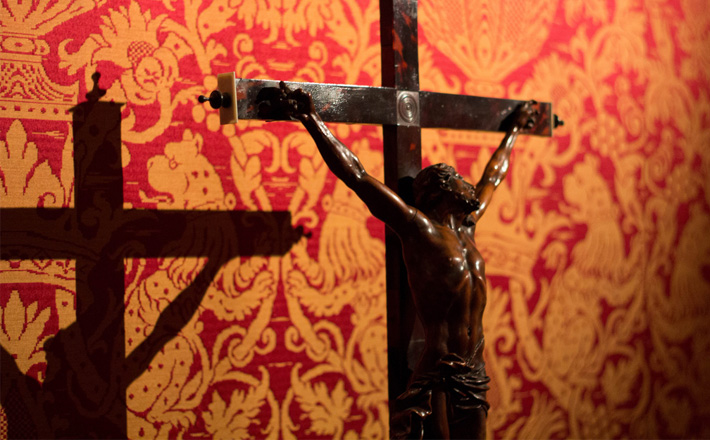Commentary on Isaiah 52:13—53:12
When reading this text, Christians have typically wondered about the identity of the servant, and more specifically whether it makes reference to Jesus.
The other “servant songs” in Second Isaiah are often consulted for hints as to the servant’s identity (Isaiah 42:1-4; 49:1-6; 50:4-9). Questions about the servant’s identity, of course, are entirely appropriate, and the text’s own ambiguity encourages us to ask them.
I want to come at these texts with a slightly different set of questions, however: What is God trying to accomplish through the servant? Another way of formulating the question is, “What is the servant’s mission?” That is to say, I’m interested, at least initially, in function rather than identity. This angle also accords well with the text itself, which, while reticent about the servant’s identity, is preoccupied with the servant’s task and the nations’ response thereto.
Such an approach, moreover, might lead us not only to ask questions about suffering servants in the past (e.g., the prophet himself or Jesus), but might also lead us to think about how God might be analogously active in, among, and through God’s contemporary “servants” in the church. I submit that this text’s ambiguity allows us — better, encourages us — to interpret the suffering servant against multiple historical and theological horizons, including our own.
God has enabled the prophet to see something in the servant’s suffering that others do not. Whereas most see him as appalling (52:14), lacking in beauty (53:2), despised by men (53:3), diseased (53:3), and of little account (53:3), the prophet, through imagistic verse, reveals a God hidden behind and actively at work in, with, and under the servant’s suffering.
The issue is not simply that the servant’s suffering has meaning — the servant’s suffering is his calling. Behind the veil of suffering, the prophet finds God’s saving work in that which is undignified, uncomely, and repulsive. The paradox this text revels in is that this shattered one, whose suffering benefits all nations, is the one to whom “the arm of the Lord has been revealed” (53:1).
But what precisely is that calling? And what is God trying to accomplish?
Isaiah 52:13-15 serve as a prelude to Isaiah 53:1-12. The poem begins with a tone of triumph:
“Indeed, my servant shall prosper,Be exalted and raised to great heights (Isaiah 52:13)
Moving beyond the first verse, one quickly realizes that, whatever victory the servant is going to achieve will be so unexpected that it will awe the nations of the earth into silence:
Just as the many were appalled at him —
So marred was his appearance, unlike that of man,
His form, beyond human semblance —
Just so he shall startle many nations.
Kings shall be silenced because of him,
For they shall see what has not been told them,
Shall behold what they never have heard.” (Isaiah 52:14-15 TNK)
Even though we aren’t given many details about the servant’s mission at this point, we do know a few things, especially about how the nations of the earth will respond to the servant: His mission will be blessed, unexpected, astounding, and even global (“nations … kings, verse 14). Somehow, through the exaltation of a servant whose form and appearance are repulsive, God will not only startle the nations but will also allow them to see and behold something entirely new (verse 15). Revelation will somehow emerge from repugnance.
In a moment of realization, the same kings and nations mentioned in verses 13-15 break the silence with a powerful confession:
“Who can believe what we have heard?
Upon whom has the arm of the LORD been revealed?
He had no form or beauty, that we should look at him:
No charm, that we should find him pleasing.
He was despised, shunned by men,
A man of suffering, familiar with disease.
As one who hid his face from us,
He was despised, we held him of no account.
Yet it was our sickness that he was bearing,
Our suffering that he endured.
We accounted him plagued,
Smitten and afflicted by God;
But he was wounded because of our sins,
Crushed because of our iniquities.
He bore the chastisement that made us whole,
And by his bruises we were healed.
We all went astray like sheep,
Each going his own way;
And the LORD visited upon him the guilt of all of us.” (Isaiah 53:1-6 TNK)
Contemplating the broken, despised, and God-forsaken body of the servant, the nations realize something about the servant’s mission and something about themselves: The sins that the servant bears are “our sins,” “our iniquities” (Isaiah 53:5). They realize that hidden behind the servant’s suffering is the saving will of God for the world.
The image of the burden-, sickness- and sin-bearing servant, then, communicates simultaneously judgment (those sins are mine!) and salvation (those sins and ailments are no longer mine!). Upon realizing God’s kindly will toward them, the nations make a powerful confession of sin:
We all went astray like sheep,
Each going his own way;
And the LORD visited upon him the guilt of all of us (emphasis mine).
Rescued from their wandering, the nations of the earth no longer gawk at the suffering servant, they now see him as their savior.
But the servant is not the only one who suffers because of the “sin” (awon) and “transgression” (peša?) of the world. In Second Isaiah more broadly, both sin and transgression are blamed for God’s “divorce” of Judah (Isaiah 50:1). Judah’s sins (awonotêka) actually weary God (Isaiah 43:24). God, it would seem, is not only hidden behind the suffering and mission of the servant, the servant’s suffering also echoes the suffering of God, who also is able to work redemption through the servant’s affliction.
The image of a vicarious, intercessory sufferer, whose hardship results in healing for the world, is certainly a profound one. Do Christians do violence to the text when they hear echoes of Second Isaiah’s suffering servant in the Christologies of the NT? No, not really. Problems only emerge when Christians assume that a Christological interpretation exhausts the text’s potential.
Such a view blinds us to how other servants might wear the “mantle” of Isaiah 52:13-53:12. On a very basic level, the servant represents the human embodiment of redemptive suffering, something God can work in any age. Understood in this way, the “mantle” of Isaiah 52-53 has been worn by many servants of God, including Moses, Jeremiah, Israel, and perhaps even Second Isaiah himself. Each of these servants suffered for God’s people, and shouldered their sins for the sake of God’s will for the world.


April 18, 2014